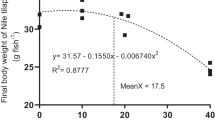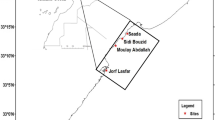Abstract
This study investigated the effects of fish meal replacement by Spirulina platensis meal on growth, survival, body biochemical composition, and reproductive performance of Trichopodus trichopterus until the first spawning for 16 weeks. The fish fed dietary algal meal at levels of 2.5, 5, 10, and 20 % against those received fish meal only as control. The results showed that indicators such as belly diameter, feed intake, feed conversion ratio (FCR), and viscerosomatic index were significantly different between treatments with 5 and 10 % algal replacements (P < 0.05). The growth factors including final weight, weight gain, total length, fork length, and body height of fish did not show significant differences (P > 0.05) between the treatments. Feed intake increased up to 10 % replacement level and then decreased, though the best FCR values (0.77–0.79) were obtained with 2.5 and 5 % substitutions. The body lipid content showed a statistically marked decrease (P < 0.05) as a result of the algal replacements, but the amounts of protein and moisture were not significantly (P > 0.05) different between treatments. All fish fed S. platensis meal had greater gonadosomatic indices (19.4–21.85 %) than that of the control in spite of insignificant differences (P > 0.05) in their ovary weights (2.07–2.21 g). Absolute fecundity ranged between 7300 and 12,700 eggs/female with the highest amount in fish fed with replaced S. platensis levels of 2.5–10 %. The second-order polynomial regression analysis between absolute fecundity and substitution levels of algal meal was y = −0.5319x 2 + 106.87x + 7812.9 (R 2 = 0.9642), and the optimal substitution level was determined to be 8.13 % for maximum absolute fecundity. Hatching percentages in the control and 20 % replacement were much lower (P < 0.05) than those in the other treatments (78–86 %). Given the relative enhancement of growth parameters and significant improvement in reproductive performance of broodstock three-spot gourami, 8.1–9.6 % S. platensis meal instead of fish meal is recommended in the diets.



Similar content being viewed by others
Abbreviations
- SP:
-
Spirulina platensis
- FCR:
-
Feed conversion ratio
- ADG:
-
Average daily growth rate
- GSI:
-
Gonadosomatic index
References
Amornsakun T, Sriwatana W, Promkaew P (2004) Some aspects in early life stage of Siamese gourami, Trichogaster pectoralis (Regan) larvae. Songklanakarin J Sci Technol 26:347–356
AOAC (2002) Association of Official Analytical Chemists. Official Methods of Analysis, 17th edn. AOAC, Arlington, Virginia, USA
Appler HN, Jauncey K (1983) The utilization of a filamentous green alga (Cladophora glomerata L. Kutzin) as a protein source in pelleted feeds for Sarotherodon (Tilapia) niloticus fingerlings. Aquaculture 30:21–30
Attack TH, Jauncey K, Matty AJ (1979) The utilization of some single cell proteins by fingerlings mirror carp (Cyprinus carpio). Aquaculture 18:337–348
Chong ASC, Ishak SD, Osman Z, Hashim R (2004) Effect of dietary protein level on the reproductive performance of female swordtails, Xiphophorus helleri (Poeciliidae). Aquaculture 234:381–392
Chou BS, Shiau SY (1996) Optimal dietary lipid level for growth of juvenile hybrid tilapia, Oreochromis niloticus × Oreochromis aureus. Aquaculture 143:185–195
Chow CY, Woo NYS (1990) Bioenergetic studies on an omnivorous fish, Oreochromis mossambicus: evaluation of utilization of Spirulina algae in feed. In: Hirano R, Hanyu I (eds) Second Asian fisheries forum. Asian Fisheries Society, Manila, pp 291–294
El-Sayed AM (1994) Evaluation of soybean meal, Spirulina meal and chicken offal meal as protein sources for silver sea bream (Rhabdosargus sarba) fingerlings. Aquaculture 127:169–176
Fernandes Silva-Neto J, Nunes AJP, Sabry-Neto H, Carmosa MV (2012) Spirulina meal has acted as a strong feeding attractant for Litopenaeus vannamei at a very low dietary inclusion level. Aquac Res 43:430–437
Food and Agriculture Organization (FAO) (2011) FAO FishStat plus. Aquaculture production 1970–2012. Rome, Italy
Gatlin DM, Barrows FT, Brown P, Dabrowski K, Gaylord TG, Hardy RW, Herman E, Krogdahl A, Nelson R, Overturf K, Rust M, Sealey W, Skonberg D, Souza EJ, Stone D, Wilson R, Wurtele E (2007) Expanding the utilization of sustainable plant products in aquafeeds: a review. Aquac Res 38:551–579
Gohl B (1981) Tropical feeds. Feed information summaries and nutritive values. FAO Animal Production and Health Series 12. FAO, Rome
Goldestein RJ (1971) Anabantoids. New Jercy, TFH Publication Inc., Neptune City, USA
Guroy B, Ahin I, Serhan M, Selin K (2012) Spirulina as a natural carotenoid source on growth, pigmentation and reproductive performance of yellow tail Cichlid (Pseudotropheus acei). Aquac Int 20(5):869–878
Habib MAB, Parvin M, Huntington TC, Hasan MR (2008) A review on culture, production and use of Spirulina as food for humans and feeds for domestic animals and fish. FAO Fisheries and Aquaculture Circular No. 1034. FAO, Rome
Hernandez GF, Hernandez LH, Araiza M, Angeles O (2012) Effects of total replacement of fish meal with Spirulina powder and soybean meal on juvenile rainbow trout (Oncorhynchus mykiss). Isr J Aquac Bamid 64:790–798
Hu Q (2004) Industrial production of microalgal cell- mass and secondary products—major industrial species Arthrospira (Spirulina) platensis. In: Richmond A (ed) Handbook of microalgal culture: biotechnology and applied phycology. Blackwell Science Ltd., Oxford, pp 264–273
Izquierdo MS, Fernandez-Palacios H, Tacon AGJ (2001) Effect of broodstock nutrition on reproductive performance of fish. Aquaculture 197:25–42
James R, Sampath K, Thangarathinam R, Vasudevan I (2006) Effect of dietary Spirulina level on growth, fertility, coloration and leucocyte count in red swordtail, Xiphophorus helleri. Isr J Aquac Bamid 58:97–104
Kalla A, Yoshimatsu T, Araki T, Zhang D, Yamamoto T, Sakamoto S (2008) Use of Porphyra spheroplasts as feed additive for red sea bream. Fish Sci 74:104–108
Kato T, Miyakawa K (1992) Growth promotion agent for fish. Japanese Patent, TOKU-KAI-HEI 5-268884
Krogdahl A, Penn M, Thorsen J, Refstie S, Bakke AM (2010) Important anti-nutrients in plant feedstuffs for aquaculture: an update on recent finding regarding responses in salmonids. Aquac Res 41:333–344
Kumaraguruvasagam KP, Shanmugam A, Rajagopalan S (2007) Dietary effect on fry production and growth performance of sail fin molly, Poecilia latipinna, in saltwater. Acta Ichthyol Et Piscat 37(1):29–35
Lu J, Takeuchi T (2004) Spawning and egg quality of the tilapia Oreochromis niloticus fed solely on raw Spirulina throughout three generations. Aquaculture 234:625–640
Matty AJ, Smith P (1978) Evaluation of a yeast, a bacterium and an alga as a protein source for rainbow trout: I. Effect of protein level on growth, gross conversion efficiency and protein conversion efficiency. Aquaculture 14(3):235–246
McKinnon JS, Liley NR (1987) Asymmetric species specificity in response to female sexual pheromone by males of two species of Trichogaster (Pisces: Belontildae). Can J Zool 65:1129–1134
Mustafa MG, Nakagawa H (1995) A review: dietary benefits of algae as an additive in fish feed. Isr J Aquac Bamid 47:155–162
Nandeesha MC, Gangadhar B, Varghese TJ, Keshavanath P (1998) Effect of feeding Spirulina platensis on the growth, proximate composition and organoleptic quality of common carp, Cyprinus carpio. Aquac Res 29:305–312
Nandeesha M, Gangadhara B, Manissery J, Venkataraman L (2001) Growth performance of two Indian major carps, catla (Catla catla) and rohu (Lebeo rohita) fed diets containing different levels of Spirulina platensis. Bioresour Technol 80:117–120
Olvera-Novoa M, Dominguez-Cen L, Olivera-Sastillo L, Martinez-Palacoice CA (1998) Effect of the use of the microalga Spirulina maxima as fish meal replacement in diets for tilapia, Oreochromis mossambicus (Peters) fry. Aquac Res 29:709–715
Palmegiano GB, Agradi E, Forneris G, Gai F, Gasco L, Rigamonti E, Sicuro B, Zoccarato I (2005) Spirulina as a nutrient source in diets for growing sturgeon (Acipenser baeri). Aquac Res 36:188–195
Palmegiano BG, Gai F, Dapra F, Gasco L, Pazzaglia M, Peiretti PG (2008) Effects of Spirulina and plant oil on the growth and lipid traits of white sturgeon (Acipenser transmontanus) fingerlings. Aquac Res 39:587–595
Promya J, Chitmant C (2011) The effect of Spirulina platensis and Cladophora alga on the growth performance, meat quality and immunity simulating capacity of the African sharptooth catfish (Clarias gariepinus). Int J Agric Biol 13:77–82
Regunthan C, Wesley SG (2006) Pigment deficiency correction in shrimp broodstock using Spirulina as a carotenoid source. Aquac Nutr 12:425–432
Reyes-Bustamante H, Ortega-Salas AA (2002) Initial sexual maturity and fecundity of two anabantids under laboratory conditions. N Am J Aquac 64:224–227
Richter HJ (1988) Gouramis and Other Anabantoids. New Jercy, TFH Publications Inc Ltd., Neptune City, USA
Rincon DD, Velasquez HA, Davila MJ, Semprun AM, Morales ED, Hernandez JL (2012) Substitution levels of fish meal by Arthrospira (Spirulina) maxima meal in experimental diets for red tilapia fingerlings (Oreochromis sp.). Rev Colomb Cienc Pecu 25:430–437
Sasson A (1997) Foreword. In: Vonhask A (eds) Spirulina platensis (Arthrospira): physiology, cell-biology and biotechnology. Taylor and Francis, London
Scabini V, Fernandez-Palacios H, Robaina L, Kalinowski T, Izquierdo MS (2011) Reproductive performance of gilthead sea bream (Sparus aurata L., 1758) fed two combined levels of carotenoids from paprika oleoresin and essential fatty acids. Aquac Nutr 17:304–312
Scaria J, Kumuthakalavalli R, Lawrence Xavier R (2000) Feed utilization and growth response of selected ornamental fishes in relation to feeds formulated with Spirulina, mushroom and water fern. Ecol Environ 8:104–108
Seifi Berenjestanaki S, Esmaeili Fereidouni A, Ouraji H, Jani Khalili K (2014) Influence of dietary lipid sources on growth, reproductive performance and fatty acid compositions of muscle and egg in three-spot gourami (Trichopodus trichopterus) (Pallas, 1770). Aquac Nutr 20:494–504
Siddhuraju P, Becker K (2001) Effect of various indigenous processing methods on the a-galactoside and mono- and disaccharide content of an Indian tribal pulse, Mucuna pruriens var. utilis. J Sci Food Agric 81:718–725
Sink T, Lochmann R (2008) Effects of dietary lipid source and concentration on channel catfish (Ictalurus punctatus) egg biochemical composition, egg and fry production, and egg and fry quality. Aquaculture 283:68–76
Spolaore P, Joannis-Cassan J, Duran E, Isambert A (2006) Commercial applications of microalgae. J Biosci Bioeng 101:87–96
Takeuchi T, Lu J, Yoshizaki G, Satoh S (2002) Effect on the growth and body composition of juvenile tilapia Oreochromis niloticus fed raw Spirulina. Fish Sci 68:34–40
Ungsethaphand T, Peerapornpisal Y, Whangchai N, Sardsud U (2010) Effect of feeding Spirulina platensis on growth and carcass composition of hybrid red tilapia (Oreochromis mossambicus × O. niloticus). Maejo Int J Sci Technol 4(02):331–336
Valente LMP, Gouveia A, Rema P, Matos J, Gomes EF, Pinto IS (2006) Evaluation of three seaweeds Gracilaria bursa-pastoris, Ulva rigida and Gracilaria cornea as dietary ingredients in European sea bass (Dicentrarchus labrax) juveniles. Aquaculture 252:85–91
Watanabe T, Vassallo-Agius R (2003) Broodstock nutrition research on marine finfish in Japan. Aquaculture 227:35–61
Watanabe T, Liao W, Takeuchi YT, Yamamoto H (1990) Effect of dietary Spirulina platensis supplement on growth performance and flesh lipids of cultured striped jack. J Tokyo Univ Fish 77:231–239
Zhou QB, Wu HD, Zhu CS, Yan XH (2011) Effects of dietary lipids on tissue fatty acids profile, growth and reproductive performance of female rice field eel (Monopterus albus). Fish Physiol Biochem 37:433–445
Acknowledgments
We wish to thank Dr. Mohammad Kazem Khalesi and Khosrow Jani Khalili, Sari Agricultural Sciences and Natural Resources University for helping in this investigation.
Author information
Authors and Affiliations
Corresponding author
Rights and permissions
About this article
Cite this article
Khanzadeh, M., Esmaeili Fereidouni, A. & Seifi Berenjestanaki, S. Effects of partial replacement of fish meal with Spirulina platensis meal in practical diets on growth, survival, body composition, and reproductive performance of three-spot gourami (Trichopodus trichopterus) (Pallas, 1770). Aquacult Int 24, 69–84 (2016). https://doi.org/10.1007/s10499-015-9909-4
Received:
Accepted:
Published:
Issue Date:
DOI: https://doi.org/10.1007/s10499-015-9909-4




